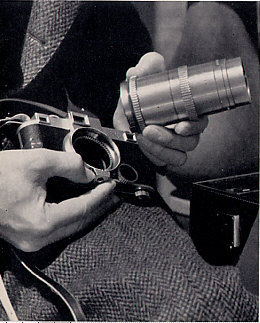| |
Lenses for Kodak Ektra
SINCE
the scope of any camera and the quality of the pictures it makes depend
in the last analysis upon its lens equipment, no feature of the Kodak Ektra
is of greater importance than its special group of Ektars. Aside from the
high over-all quality indicated by their name, these lenses provide great
optical adaptability, precision interchangeability, unique structural and
operating advantages, and, in the case of the f/1.9, ultra-speed.
A range of superb new lenses
As is true of the
rest of the camera, the lenses are entirely new--in formula, in mounting,
and in many aspects of their focusing and general use. All were computed
and designed specifically as component parts of the Ektra, and as members
of a group of lenses whose combined ranges would complement each other
in a wide, related series of magnifications. Kodak lens scientists, working
with the designers of the camera proper, took into account not only the
size and other specifications, but also the means for effectively coordinating
the lenses with both the range-finder and view-finder systems. And these
lens designers, and the craftsmen who executed their designs, had constantly
before them the standards of accuracy, workmanship, and performance specified
for the camera as a whole. The resulting family of Kodak Ektars challenges
comparison with any other group of lenses. Their design embodies to a
high degree all of the corrections essential for fine photography, and
especially important for precision miniature work. Because of the growing
importance of full-color photography, particular attention has been given
to both lateral and longitudinal color correction.*
|
|
| |
 |
|
Surface treatment
The inner surfaces
of the lenses are treated by coating process that improves the clarity
and brilliance of the negatives obtained. This surface-coating process,
forms of which have been widely publicized, reduces reflections from the
sur-
*The
fault known as "lateral color," or chromatic difference of magnification,
results in objectionable color fringes along the edges of a color picture.
"Longitudinal color," caused by the registering of different
colors in planes other than the true focal plane, results in fuzziness.
Lenses for the Ektra have excellent correction for both of these faults.
|
|
